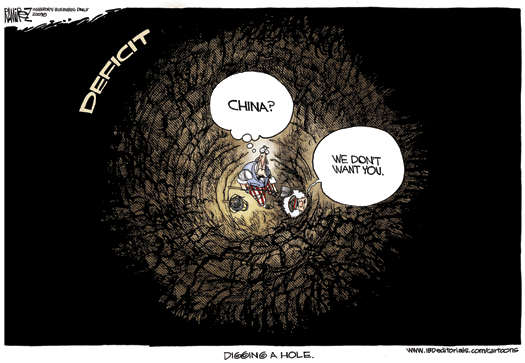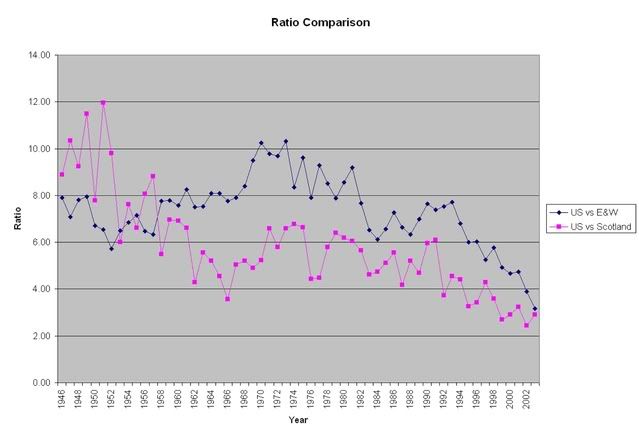The BBC Takes an Interest in Tennessee Gun Laws
I guess since the UK has enacted “the toughest gun laws in the world”, designed to “put a firm brake on the development of a dangerous gun culture in the UK,” they have to find their jollies vicariously:
Tennessee gun law divides opinion
By James Coomarasamy
BBC News, Nashville, Tennessee
Just an aside, but I’d really be interested in Mr. Coomarasamy’s personal take on being in Tennessee. Since Knoxville seems to be Blogger Central, perhaps one of the many bloggers there could put on their pajamas and interview him?
Following a recent series of high-profile shooting incidents in the United States, the southern state of Tennessee is changing its gun laws this week.
It is relaxing them.
If a last-minute legal challenge fails, from Tuesday, gun owners in the state will be allowed to carry their weapons in a lot more public places – including bars and restaurants.
I went to Nashville to find out what local residents thought about the proposed law change.
‘Seconds count’
Nikki Goeser takes her Second Amendment right to bear arms very seriously.
One of Tennessee’s 250,000 registered gun owners, she saw her husband, Ben, shot dead in front of her in April.
She believes her right was denied when she needed it most.
http://news.bbc.co.uk/player/emp/external/player.swf
(Hooray for the BBC!)
I don’t believe Tennessee actually registers its gun owners – just the ones who have concealed carry licenses. Somehow I doubt Mr. Coomarasamy (or at least his editors) understands the difference.
Soon, Tennessee’s bars and restaurants will no longer be off-limits for registered weapons.
State legislators – a quarter of whom own firearms – have passed a law allowing guns into bars and restaurants, but preventing their owners from buying alcohol.
For the bill’s Democratic sponsor – State Senator Doug Jackson – it is a case of preserving the rights of individuals and those of individual states.
“People are fearful about tomorrow. They feel insecure. And the Second Amendment right is something that they cherish and it’s a means of protecting themselves and their family and defending what they have. It provides security in troubled times.”
But on the streets of Nashville, even some staunch defenders of Second Amendment rights fear that the Music City is about to become Dodge City. And that mixing guns and alcohol is a recipe for disaster.
Even though it’s not in any of the other states where it’s legal to do what Tennessee just enacted. Odd that Mr. Coomarasamy (or his editors) didn’t mention that.
Nashville restaurateur Randy Rayburn is anything but cool about the idea of his customers having guns.
He is leading a last-minute legal challenge to the law – to protect his barmen.
“Yes they’re scared, I’m scared, my wife is scared for our personal safety.”
He has done what restaurant owners are permitted to do – placed a sign in his window, saying “no guns allowed”.
But he is worried that the sign will not be enough to prevent people taking the new law into their own hands.
Er, what? Protect his barmen from what exactly? He expects CCW carriers to break the law, get drunk, and shoot the place up?
“We don’t need vigilantism inside my business,” he says. “I’m a gun owner, I have a gun at my home, but I keep it there, not at a public place where many people’s lives can be threatened.
Oh, right – vigilantism – he expects his patrons to pull out their gats and shoot bad guys for NO REASON. AND his barmen.
I think Nikki Goeser might want a word with Mr. Rayburn.
But Rayburn isn’t alone:
And he has support from the city’s police chief, Ronal Serpas, who does not believe that people who walk into bars with guns will steer clear of the shot glasses.
“If you think about how alchohol influences the choices people make… I don’t believe people are not going to drink and have guns, because I know they drink and drive,” he says.
“What process is going through their mind as it’s clouded by alcohol? [They’re] trying to do a good thing, but they have NO training, NO experience, NO time for reflective thought, and their minds are consumed by alcohol – it doesn’t make sense.”
So it’s Chief Serpas who believes that licensed CCW holders will violate the law and get drunk while armed, although up till now they’ve obeyed the law and not carried into establishments that serve alcohol. Always good to know what Law Enforcement thinks of the people it works for. In this case the Chief thinks that alcohol must give off the brain-altering waves that force people to drink.
Nikki gets the last word in the piece, though:
But for Nikki – and other law-abiding gun owners – what does not make sense is being allowed to have a gun, but being prevented from using it when it counts
“I hear people say all the time, guns are made specifically to kill,” she tells me.
“My answer to that is: ‘yes a gun can kill, but in the correct hands, it can be used to save innocent lives’. I don’t care so much about a bad guy’s life. I’m sorry, I don’t. They make the choice to be evil, that’s their choice. If they choose that, and I am armed I know what I’m doing, I will try to stop them.”
And soon she will be allowed to – in a lot more places.
Boy, it’s a good thing the UK has the toughest gun laws in the world, and doesn’t have to worry about people carrying handguns into restaurants anymore . . .
Gunman opens fire in restaurant
A man and a 15-year-old boy are recovering from bullet wounds after a gunman opened fire in a packed restaurant in west London.
Both suffered non-life threatening injuries during the shooting in Harry Morgan’s restaurant in St John’s Wood High Street, at 2110 BST on Friday.
The attacker, carrying two guns, chased the 31-year-old man into the diner and opened fire, hitting him in the leg.
But that’s UNPOSSIBLE!! The UK has the TOUGHEST GUN LAWS IN THE WORLD!!
The Metropolitan Police said no arrests have yet been made.
Because they arrived just in time to put up crime scene tape and take reports.
Several shots were fired in the venue which was filled with people.
Pop star Rachel Stevens was dining at the venue at the time.
A spokeswoman for the former S Club 7 member said: “Rachel and her family were in a restaurant where there was gunfire. It was very frightening for everyone there but none of the diners were hurt.”
An eyewitness said diners threw themselves to the floor screaming and bullet-holes could now be seen.
And, being unarmed, all they could to was huddle there waiting to die.
BBC chief economics correspondent Hugh Pym was also in the restaurant at the time.
He said: “I immediately went to ground and pulled my 15-year-old son under the table.
“We were aware of a guy running through.
“He didn’t appear as if he had a weapon – it felt like he was the victim.”
Pym continued: “We were under the table and everyone was shouting ‘stay down, stay down’.
“Obviously there was a lot of broken glass and people gradually emerged from the tables.
“People were pretty shaken up and were wailing in shock more than anything else.”
Billy Osbourne was also in the restaurant and saw the first man run in.
“Then all of a sudden a guy in a motorbike helmet came in – he had two automatic pistols and he starts firing at the guy.
UNPOSSIBLE! Handguns have been banned in the UK since 1997!!
“As soon as I smelled the cordite I was under the table.
“Everyone was screaming and hitting the deck.
“It was unbelievable – it was a packed restaurant and it does not appear anybody [among the diners] was hurt.”
The shooter was probably a lousy shot.
Harry Morgan’s was established in 1948 by a London butcher and has been shortlisted in the Evening Standard Restaurant Awards.
I bet they counted on a “Gun Free Zone” sign to protect their patrons, too.
Oh, right. The entire country is a “Gun Free Zone.” How’s that working out for you?
(h/t AR15.com for these two stories.)

